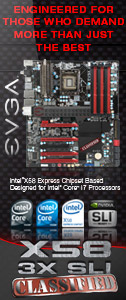
Introduction
EVGA, long known for their Nvidia based video card products, has been making some great strides over the past couple of years in the motherboard market. EVGA currently offers several X58 chipset motherboards, with their Classified series being the flagship offering. There are two available Classified versions, one with the NF200 chipset and one without. The only major difference between these two offerings is the E759 Model has the NF200 chpset onboard, allowing for a 3-way X16 SLI configuration, whereas the E760 version does not have the NF200 chipset meaning a 3-way SLI will be a X16-X16-X8 configuration.
This review will be on the higher end E759 version with a water cooling twist. A full system water cooling setup was obtained for this review. There are plenty of other reviews out there on this motherboard using the stock cooling, so it was decided to do something a little different this time around and review the board outfitted with a water cooling setup. These Classified motherboards hit the market with a lot of fanfare, and great expectations. Does the motherboard live up to the hype? Are they worth the premium price? How effective is the water cooling? These questions and more will be explored in this review.
Pricing
Pricing for the EVGA X58 Classified (E759) was $449.00US at the time of this review, with the E760 version availabe for $419.00US. For our UK readers the E759 weighed in at around £329 Inc VAT, and the E760 around £310 Inc VAT. Certainly not an inexpensive motherboard and geared toward the hardcore enthusiast at that price range.
Packaging
The art work on the front of the box gives the appearance of a military theme and proudly announces the X58 Classified logo. The back of the box continues the same theme along with a description of the motherboard features and package contents.
 |
 |
Upon opening the box you are greeted with a host of accessories. The list of included items is quite long and everything you could possibly need is included. Here is a rundown of the included accessories.
- eVGA X58 Classified Motherboard 141-BL-E759-A1 (NF200)
- eVGA Driver Installation CD With eVGA E-LEET
- Rear Case I/O Shield
- 6 SATA Data Cables
- 3 SATA Power Cables
- 1 Rounded IDE Cable
- 3 SLI Bridges – Standard 2 way, 3 way, and extended 3 way
- 2 Port USB / 1394a Firewire Bracket
- Visual Installation Guide
- User Manual
- EPC Multi Function Unit
The following is a group of pictures showing the package contents as they are revealed.
 |
 |
 |
 |
 |
Specifications
|
|
|
|
|
|
|
|
|
|
|
|
|
|
|
|
|
|
|
|
|
|
|
|
| Aditional Features | |
|
|
|
|
|
|
|
|
|
|
|
|
|
|
|
|
|
|
|
|
A Closer Look and Under the Hood
Lets take a quick tour around the motherboard and see up close everything it has to offer. The following four images give you a full board view from all four angles. The first photo shows the rear I/O area. This area is packed with available connections. There are eight USB 2.0 connections, a single PS/2 connection for a keyboard, a clear CMOS button, Coax and Optical audio ouputs, 1394a Firewire connector, one e-SATA connector, two LAN ports, and finally the 8 channel analog audio connections.
The second photo shows the bottom area of the motherboard. Here is where you will find the onboard power and reset buttons. Additionally there is a system speaker, the two internal USB connectors, two system fan headers, the front panel connectors, and the EPC connection header.
In the third photo, a good look at the right side of the board shows where all the SATA connections are located. Looking further you will see the IDE port, and the 24 pin main power connector.
Finally the fourth picture is a shot of the top of the board. As you can see the CPU area is wide open for almost any cooling solution you choose to use. Also the six DDR3 slots can be seen, along with an attached sticker explaining how to populate the slots.
 |
 |
 |
 |
Next we will explore the X58 Classified up close. The pictures below give you a detailed view of the different areas including the CPU area, the Dimm slot area, all the different heatsink assemblies, PCI & PCI-e Slots, the I/O area. Some highlights include the double 8 pin CPU power leads, the massive Northbridge heatsink, and the absence of a floppy drive connector. If your PSU does not have two 8 pin CPU +12v connectors, a single lead works fine. Apparently the optional second 8 pin connector is to provide extra power under extreme overclocking conditions. You may also notice the absence of a floppy drive cable connection. If you want to use a floppy drive with this motherboard you will need to purchase a USB interface floppy drive. The Northbridge heatsink should provide good cooling just based on the size of it and the fact you can easily mount a fan to it. There are fan mounting holes available on the Northbridge heatsink.
 |
 |
 |
 |
 |
 |
 |
 |
 |
 |
 |
As is customary here at Gilgamesh Reviews, we like to remove the stock cooling and have a look under the hood so to speak. Its worth mentioning the excellent job eVGA has done getting the thermal pad under the PWM heatsink to actually make contact with all the PWM chips. This is the first motherboard reviewed that had the PWM heatsink making contact across all the PWM chips….. Nicely done!
Here are some pictures of the removed heatsink assembly, and the exposed chipsets. Note the excellent application of thermal paste to the different areas. Much too often other manufacturers apply heatsink compound sloppy and without much attention to detail.
 |
 |
 |
 |
 |
 |
The Build
Before the review of the motherboard begins lets go over the water cooling items used and a brief overview of the build process. Because a triple 120mm fan radiator was used (Black Ice Extreme III 360), the obvious choice for positioning of the radiator was under the top panel. Using a Lian-Li PC75B full tower case for the build afforded the opportunity to buy a pre drilled top panel. The rivets were removed to relieve the stock top panel from the case, and then the new top panel was riveted in place. Here are a couple of pictures of the newly installed top panel.
 |
 |
Next the Radiator was outfitted with the fans, we used three Scythe 120mm 2000 RPM units.
 |
 |
Here are a couple shots of the radiator installed.
 |
 |
The CPU block for this build was the Alphacool Yellowstone HF14. For the mosfet cooling a Bitspower Black Freezer unit was chosen. The full board block used was a Koolance EVX58CF unit. For the pump and reservoir a Alphacool Laing DDC Ultra Water Tank was installed. Below are a few pictures of the motherboard outfitted with the different blocks.
 |
 |
 |
And finally a few shots of the completed system.
 |
 |
 |
The BIOS
As is true with most motherboards, the available BIOS setting options are what seperate a run of the mill board from an enthusiast product. The eVGA X58 Classified does not disappoint when it comes to available BIOS/Overclocking options. Everything needed to tune your overclock to it’s maximum potential can be found in the Frequency/Voltage Control section of BIOS.
Lets have a look around the different BIOS screens. The eVGA X58 Classified uses an Award BIOS and arrived with the latest BIOS available at the time of this review. The first set of BIOS screens are common to most motherboards, so lets first have a look at these. Here are some pictures of the main screen, standard CMOS features, advanced BIOS features, integrated peripherals, power management setup, PNP/PCI Configuration, and finally the PC Health section.
 |
 |
 |
 |
 |
 |
 |
|
Next lets have a look at the Frequency/Voltage Control section of BIOS. This is obviously where all your overclocking parameters can be found. eVGA has done a great job with the layout and the available options here, well done! A very nice feature in this section is the ability to save and load BIOS profiles. One improvement to this profile saving option would be to add the ability to name the profiles you save. As it stands now, you just assign a saved profile a number. If you forget what settings you loaded in a particular profile, it will be necessary to actually load it and have a look manually at the settings.
In the memory features section you have the ability to fine tune your memory timings and frequency. Very little if anything at all was left out of these options, lot of memory tweaking can be done here.
The voltage control section presents you with a plethora of options. The ability to manipulate voltages for just about every sub system is there. Here is a run down of all the voltage options and the range of voltages.
| Option | Range |
| CPU | 1.00v to 2.24v |
| CPU VTT | +0mv to +1.00mv |
| CPU PLL VCORE | 0.600v to 2.700v |
| IOH PLL VCORE | 0.600v to 2.700v |
| QPI PLL VCORE | 1.100v to 1.875v |
| DIMM VOLTAGE | 0.700v to 3.390v |
| IOH VCORE | 1.100v to1.875v |
| IOH/ICH I/O Voltage | 1.500v to 2.275v |
| ICH VCORE | 1.050v to 1.825v |
| NF200 VOLTAGE | 0.700v to 2.700v |
The CPU feature area is where you find such things as the Intel Speed Step options, Turbo Mode settings, Hyper-Threading options, and the QPI settings. Below are the pictures of the Frequency/Voltage Control areas.
 |
 |
 |
 |
Testing and Benchmarks
It must be noted at this time that the first motherboard we received would not boot up for us. We attempted a bare bones boot attempt with just the CPU & Fan, one stick of memory, and the video card, this was all tried before any of the heatsinks were removed or water cooling parts installed. The post code display would read “FF” immediately upon turning on the power and never move from there. It has been observed to be an issue others have experienced as well. A call was placed to eVGA, but the determination was made that the motherboard was indeed bad.
eVGA cross shipped a replacement the very next day and the replacement motherboard booted right up. Having a bad board the first time around gave us the opportunity to review the customer service level of eVGA. You willl be hard pressed to find any company offering the level of customer service that eVGA provides, hands down….. second to none. Never were we on hold more than a few minutes, their support staff was polite and seemed to genuinely care about the problem described. They paid the shipping to send the replacement, and enclosed a return shipping label to send the bad board back. This results in a “No Cost” replacement for the end user.
Once the second motherboard was deemed to be in good working order, everything was assembled as outlined earlier in this review. For benchmark testing purposes the following tests were used using Windows Vista HP X64 SP2:
- HDD Tach testing IDE and Raid functions
- SuperPI 1M at 2.66 Ghz (Stock w/Turbo Mode Enabled), 3.6 Ghz, 4.0 Ghz, and 4.2 Ghz
- The complete Everest 5.0 suite of Memory, CPU, and FPU tests at 2.66 Ghz (Stock), 3.6 Ghz, 4.0 Ghz, and 4.2 Ghz
The first set of tests were performed using HDD Tach 3.0 in order to check the performance of the Intel SATA controllers. The IDE function was tested first, using both the 8mb and 32mb tests. Here are the screenshots of those results.
| HDD Tach 8Mb IDE | HDD Tach 32Mb IDE |
 |
 |
A raid0 array was setup with two Western Digital Raptors, these were the 150Gb 16Mb Cache versions. Here are the screen shots for the 8Mb and 32Mb runs.
| HDD Tach 8Mb Raid | HDD Tach 32Mb Raid |
 |
 |
The results of these tests show the Intel controller in IDE mode and Raid Mode perform as expected. The results are typical for the ICH10R series controllers.
The next benchmark was SuperPI 1M, run at stock speed of 2.66 Ghz, 3.6 Ghz, 4.0 Ghz, and finally 4.2 Ghz. As expected the times were better as the overclock setting was higher. The 10 second barrier was broken when run at the 4.2 Ghz overclock. Here are the screen shots of all the results at the various CPU speeds.
| SuperPI 1M @ 2.66 Ghz | Super PI 1M @ 3.6 Ghz |
 |
 |
| SuperPI 1M @ 4.0 Ghz | SuperPI 1M @ 4.2 Ghz |
 |
 |
Next the full battery of Everest 5.0 benchmarks were run at the four different CPU speeds mentioned above. The memory frequency was set at 2:8 for all the different CPU speeds.
The first set of Everest benchmarks test the memory performance. The default comparisons systems loaded in to Everest are a good indication of how the system performs compared to other platforms. As you can see by these results, at or near the top of the chart was the norm here, especially as the overclock was increased.
| Memory Read Test @ 2.66 Ghz | Memory Read test @ 3.6 Ghz |
 |
 |
| Memory Read Test @ 4.0 Ghz | Memory Read Test @ 4.2 Ghz |
 |
 |
| Memory Write Test @ 2.66 Ghz | Memory Write Test @ 3.6 Ghz |
 |
 |
| Memory Write Test @ 4.0 Ghz | Memory Write Test @ 4.2 Ghz |
 |
 |
| Memory Copy Test @ 2.66 Ghz | Memory Copy Test @ 3.6 Ghz |
 |
 |
| Memory Copy Test @ 4.0 Ghz | Memory Copy Test @ 4.2 Ghz |
 |
 |
| Memory Latency Test @ 2.66 Ghz | Memory Latency Test @ 3.6 Ghz |
 |
 |
| Memory Latency Test @ 4.0 Ghz | Memory Latency Test @ 4.2 Ghz |
 |
 |
Next, the four CPU tests were run, no surprise that the results got better as the overclocks got higher.
| CPU Queen Test @ 2.66 Ghz | CPU Queen Test @ 3.6 Ghz |
 |
 |
| Cpu Queen Test @ 4.0 Ghz | CPU Queen Test @ 4.2 Ghz |
 |
 |
| CPU Photoworxx Test @ 2.66 Ghz | CPU Photoworxx Test @ 3.6 Ghz |
 |
 |
| CPU Photoworxx Test @ 4.0 GHz | CPU Photoworxx Test @ 4.2 Ghz |
 |
 |
| CPU Zlib Test @ 2.66 Ghz | CPU Zlib Test @ 3.6 Ghz |
 |
|
| CPU Zlib Test @ 4.0 Ghz | CPU Zlib Test @ 4.2 Ghz |
 |
 |
| CPU AES Test @ 2.66 Ghz | CPU AES Test @ 3.6 Ghz |
 |
 |
| CPU AES Test @ 4.0 Ghz | CPU AES Test @ 4.2 Ghz |
 |
 |
Next up the FPU battery of tests were run, near the top in every category.
| FPU Julia Test @ 2.66 Ghz | FPU Julia Test @ 3.6 Ghz |
 |
 |
| FPU Julia Test @ 4.0 Ghz | FPU Julia Test @ 4.2 Ghz |
 |
 |
| FPU Mandel Test @ 2.66 Ghz | FPU Mandel Test @ 3.6 Ghz |
 |
 |
| FPU Mandel Test @ 4.0 Ghz | FPU Mandel Test @ 4.2 Ghz |
 |
 |
| FPU Sinjulia Test @ 2.66 Ghz | FPU Sinjulia Test @ 3.6 Ghz |
 |
 |
| FPU Sinjulia Test @ 4.0 Ghz | FPU Sinjulia Test @ 4.2 Ghz |
 |
 |
Overclocking
With the abundant BIOS overclocking options, a D0 stepping i7 920 CPU, and a complete watercooling setup, expectations were high as we started the overclocking process. With expectations so high, we jumped right in to a solid 1Ghz overclock setting. With just a small bump in vCORE voltage and just about everything else in BIOS left at the “Auto” setting, 3.6Ghz was no problem at all. Each overclock was tested with a quick thirty minute run of Prime95. A longer run of Prime95, at least several hours, should be completed to insure “Complete” stability. These overclocks are presented as a good starting point only, but they appeared to be stable as they also completed all the benchmarks we threw at them. The water cooling setup seems to be performing quite well!
The following is a screen shot of the 3.6Ghz overclock along with the BIOS template.
3.6 Ghz BIOS Template
Mother Board ( EVGA X58 Classified )
Drivers ( Intel Chipset 9.1.0.1007 )
Bios ( S21S )
CPU ( i7 920 D0 stepping )
CPU Cooler ( Alhpacool Yellowstone HF14)
Memory ( G.Skill F3-1600CL8T-6GBPS Perfect Storm 8-8-8-21 1T DDR3-2000)
PSU ( PCP&C 750 )
GPU ( EVGA GTX260 )
Drivers ( 185.85 )
Operating System ( Vista X64 HP SP2 )
Frequency Control
CPU Clock Ratio ( 20X )
CPU Host Frequency (Mhz) ( 180 )
MCH Strap ( Auto )
CPU Uncore Frequency (Mhz) ( Auto )
CPU Clock Skew ( 0 ps )
Spread Spectrum ( Disabled )
PCIE Frequency (Mhz) ( 100 )
Memory Feature
Memory Speed ( Standard )
Memory Control Setting ( Enabled )
Memory Frequency ( 1067Mhz / 2:8 )
Channel Interleave Setting ( 6 Way )
Rank Interleave Setting ( 4 Way )
Memory Low Gap ( Auto )
tCL Setting ( 8 )
tRCD Setting ( 8 )
tRP Setting ( 8 )
tRAS Setting ( 21 )
tRFC Setting ( 74 )
Command Rate ( 1t )
Voltage Control
EVGA VDroop Control ( W/VDroop )
CPU VCore ( 1.26250 )
CPU VTT Voltage ( +200mv )
CPU PLL VCore ( Auto )
IOH PLL VCore ( Auto )
DIMM Voltage ( 1.65 )
QPI PLL VCore ( Auto )
IOH VCore ( Auto )
IOH/ICH I/O Voltage ( Auto )
ICH VCore ( Auto )
NF200 Voltage ( Auto )
VTT PWM Frequency ( 250 KHZ )
CPU PWM Frequency ( 800 KHZ )
CPU Impedance ( Auto )
QPI Signal Compensation ( Auto )
CPU Feature
Intel SpeedStep ( Disabled )
Turbo Mode Function ( Disabled )
CxE Function ( Disabled )
Execute Disable Bit ( Enabled )
Virtualization Technology ( Disabled )
Intel HT Technology ( Enabled )
Active Processor Cores ( All )
QPI Control Settings ( Enabled )
QPI Link Fast Mode ( Enabled )
QPI Frequency Selection ( Auto )
Next an overclock of 4.0Ghz was attempted. Here we needed to give the system a little more CPU VTT voltage, and another couple bumps in vCORE. No problem here either, off and running at 4.0Ghz! Again, the water cooling components are doing their job keeping temps at very good levels.
4.0 Ghz BIOS Template
Mother Board ( EVGA X58 Classified )
Drivers ( Intel Chipset 9.1.0.1007 )
Bios ( S21S )
CPU ( i7 920 D0 stepping )
CPU Cooler ( Alhpacool Yellowstone HF14 )
Memory ( G.Skill F3-1600CL8T-6GBPS Perfect Storm 8-8-8-21 1T DDR3-2000)
PSU ( PCP&C 750 )
GPU ( EVGA GTX260 )
Drivers ( 185.85 )
Operating System ( Vista X64 HP SP2 )
Frequency Control
CPU Clock Ratio ( 20X )
CPU Host Frequency (Mhz) ( 200 )
MCH Strap ( Auto )
CPU Uncore Frequency (Mhz) ( Auto )
CPU Clock Skew ( 0 ps )
Spread Spectrum ( Disabled )
PCIE Frequency (Mhz) ( 100 )
Memory Feature
Memory Speed ( Standard )
Memory Control Setting ( Enabled )
Memory Frequency ( 1067Mhz / 2:8 )
Channel Interleave Setting ( 6 Way )
Rank Interleave Setting ( 4 Way )
Memory Low Gap ( Auto )
tCL Setting ( 8 )
tRCD Setting ( 8 )
tRP Setting ( 8 )
tRAS Setting ( 21 )
tRFC Setting ( 88 )
Command Rate ( 1t )
Voltage Control
EVGA VDroop Control ( W/VDroop )
CPU VCore ( 1.2875 )
CPU VTT Voltage ( +200mv )
CPU PLL VCore ( Auto )
IOH PLL VCore ( Auto )
DIMM Voltage ( 1.65 )
QPI PLL VCore ( Auto )
IOH VCore ( Auto )
IOH/ICH I/O Voltage ( Auto )
ICH VCore ( Auto )
NF200 Voltage ( Auto )
VTT PWM Frequency ( 250 KHZ )
CPU PWM Frequency ( 800 KHZ )
CPU Impedance ( Auto )
QPI Signal Compensation ( Auto )
CPU Feature
Intel SpeedStep ( Disabled )
Turbo Mode Function ( Disabled )
CxE Function ( Disabled )
Execute Disable Bit ( Enabled )
Virtualization Technology ( Disabled )
Intel HT Technology ( Enabled )
Active Processor Cores ( All )
QPI Control Settings ( Enabled )
QPI Link Fast Mode ( Enabled )
QPI Frequency Selection ( Auto )
Well, lets try one more shall we? 4.2Ghz was our next and final overclocking attempt. Here we had to start adjusting several different voltages to achieve stability, but once the right combination was found, success was obtained. Pay attention to the BIOS template below to see where all the voltage changes were made, there are quite a few. Temps still well within specs at this point!
4.2 Ghz BIOS Template
Mother Board ( EVGA X58 Classified )
Drivers ( Intel Chipset 9.1.0.1007 )
Bios ( S21S )
CPU ( i7 920 D0 stepping )
CPU Cooler ( Alhpacool Yellowstone HF14 )
Memory ( G.Skill F3-1600CL8T-6GBPS Perfect Storm 8-8-8-21 1T DDR3-2000)
PSU ( PCP&C 750 )
GPU ( EVGA GTX260 )
Drivers ( 185.85 )
Operating System ( Vista X64 HP SP2 )
Frequency Control
CPU Clock Ratio ( 20X )
CPU Host Frequency (Mhz) ( 210 )
MCH Strap ( Auto )
CPU Uncore Frequency (Mhz) ( Auto )
CPU Clock Skew ( 0 ps )
Spread Spectrum ( Disabled )
PCIE Frequency (Mhz) ( 100 )
Memory Feature
Memory Speed ( Standard )
Memory Control Setting ( Enabled )
Memory Frequency ( 1067Mhz / 2:8 )
Channel Interleave Setting ( 6 Way )
Rank Interleave Setting ( 4 Way )
Memory Low Gap ( Auto )
tCL Setting ( 8 )
tRCD Setting ( 8 )
tRP Setting ( 8 )
tRAS Setting ( 21 )
tRFC Setting ( 88 )
Command Rate ( 1t )
Voltage Control
EVGA VDroop Control ( Without VDroop )
CPU VCore ( 1.30v )
CPU VTT Voltage ( +300mv )
CPU PLL VCore ( 1.905v )
IOH PLL VCore ( Auto )
DIMM Voltage ( 1.65v )
QPI PLL VCore ( 1.325v )
IOH VCore ( 1.325v )
IOH/ICH I/O Voltage ( 1.625v )
ICH VCore ( 1.225v )
NF200 Voltage ( Auto )
VTT PWM Frequency ( 490 KHZ )
CPU PWM Frequency ( 940 KHZ )
CPU Impedance ( Auto )
QPI Signal Compensation ( Auto )
CPU Feature
Intel SpeedStep ( Disabled )
Turbo Mode Function ( Disabled )
CxE Function ( Disabled )
Execute Disable Bit ( Disabled )
Virtualization Technology ( Disabled )
Intel HT Technology ( Enabled )
Active Processor Cores ( All )
QPI Control Settings ( Enabled )
QPI Link Fast Mode ( Enabled )
QPI Frequency Selection ( 4.800 GT/s )
This combination obviously has a lot more in it, I’m sure with ample time and effort an overclock of 4.5Ghz or more could be achieved. The whole overclocking experience with this board was a pleasure, and the results were tremendous.
Final Thoughts and Conclusion
Seldom does a motherboard release accompanied with this much fanfare live up to the hype. While the board is not perfect, it’s about as close to it as you will find in the X58 platform. So, does it live up to the advance billing? The answer to that is a resounding YES!
The eVGA X58 Classified is jam packed with features, overclocking options, and a box full of accessories. While the price tag is pretty hefty, one is left with the feeling that it is money well spent. The only dark cloud was the defective unit received initially, but eVGA’s customer support made the RMA process painless and quick, just what people that experience a problem expect.
Most enthusiasts that purchase this motherboard do so with the intent of overclocking it heavily, and the eVGA X58 Classified will not disappoint. Our overclocking adventures yielded great results with minimul effort. For those hard core overclockers out there, you will find plenty to keep you occupied for quite a while as you take this Motherboard to the extreme limits. In fact you will find both BIOS settings and motherboard jumpers that can be set for extreme cooling as well. Further evidence that the extreme overclocker was the target audience.
| Pros | Cons |
|
|
Here at Gilgamesh Reviews we have a three tier rating system. A Silver Award, an Editors Choice Award, and our top honor the Gold Award. To achieve the Gold Award a product must demonstrate a performance level above and beyond the normal, the eVGA X58 Classified does exactly that. The customer support received during the RMA process further solidified the justification for the Gold Award.
![]()











